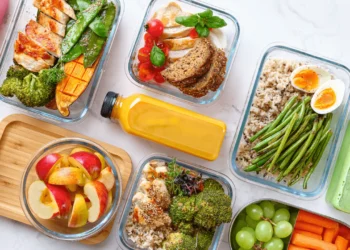As our schedules fill up and life gets hectic, our kitchens become a bustling hub of activity.
However, amidst all our commitments and responsibilities, a particularly busy week can also be a time of heightened stress on top of culinary demands. We definitely understand the need for simplicity and efficiency when it comes to meal prep, so we put together a straightforward, transformable dinner-to-lunch recipe that is both practical and pretty yummy.
This multipurpose approach to cooking is designed to alleviate the stress of meal planning when you’re hit with those crazy, busy weeks so you can focus on what matters most and drop the stress of the kitchen duties.
Our Lemon Garlic Chicken with Roasted Vegetables is a perfect example of an uncomplicated meal brimming with flavor, suitable for a cozy family dinner.
The beauty of this recipe lies in its 2-in-1 versatility; with minimal additional effort, the leftovers are transformed into a completely different dish – a refreshing Chicken Veggie Pasta Salad for lunch. This not only maximizes your time and resources, but also adds an element of variety to your weekly meals.
In crafting this plan, we’ve considered the essence of efficient cooking:
- dishes that bring comfort and satisfaction
- flavors that energize and nourish
- methods that respect your time and energy
Whether you’re a seasoned cook or a beginner in the kitchen, this recipe is designed to be accessible, straightforward, and adaptable. It’s about embracing a busy week with all its demands without letting the pressure of cooking overshadow the joy of sharing good food.
Why an Easy, Transformable Dinner-to-Lunch Recipe?
Amid your weekly busyness, having a meal plan that is both efficient and versatile can be a lifesaver. An easy, transformable dinner-to-lunch recipe offers several benefits that make it ideal for those hectic nights:
- Time and Energy Saving: Time is precious. A recipe that serves a dual purpose means you spend less time cooking and more time enjoying your life.
- Cost-Effective: Utilizing leftovers in a creative way not only reduces food waste but also saves money. By transforming dinner into a different meal for lunch the next day, you maximize the use of your ingredients and get more value out of your grocery shopping.
- Variety and Interest: Transforming dinner leftovers into a new meal for lunch keeps things interesting. It prevents the monotony of eating the same meal repeatedly and allows you to enjoy a different flavor profile without too much extra effort.
Spring Vegetable Frittata: A Frugal March Recipe | Budget-Friendly Recipes
Dinner Recipe: Lemon Garlic Chicken with Roasted Vegetables
Ingredients:
- 4 boneless, skinless chicken breasts (about 2 lbs.)
- 2 lemons, one juiced and one sliced
- 4 cloves garlic, minced
- 1/4 cup olive oil
- 1 tsp dried thyme
- 1 tsp dried rosemary
- Salt and pepper to taste
- 2 lbs. mixed vegetables (e.g., bell peppers, zucchini, cherry tomatoes, and red onions), chopped
- 1 tbsp. balsamic vinegar
Total cost: Around $20.
Serves: 4 for dinner, with leftovers for lunch.
Cooking Directions:
- Marinate Chicken: In a bowl, mix lemon juice, half of the minced garlic, 2 tablespoons of olive oil, thyme, rosemary, salt, and pepper. Add chicken breasts and marinate in the refrigerator for at least 30 minutes.
- Roast Vegetables: Preheat the oven to 400°F (200°C). Toss the chopped vegetables with the remaining olive oil, balsamic vinegar, the rest of the garlic, salt, and pepper. Spread on a baking sheet and roast for 20-25 minutes until tender and slightly caramelized.
- Cook Chicken: Heat a skillet over medium heat. Remove chicken from the marinade and cook for 5-7 minutes on each side or until fully cooked (internal temperature of 165°F). Add lemon slices to the skillet in the last few minutes for extra flavor.
- Serve: Plate the chicken with a side of roasted vegetables and garnish with roasted lemon slices.
Lunch Transformation: Chicken Veggie Pasta Salad
Additional Ingredients:
- 2 cups cooked pasta (e.g., penne or fusilli)
- 2 tbsp. mayonnaise or Greek yogurt
- 1 tbsp. mustard
- 1 tbsp. lemon juice
- Fresh herbs (optional, like parsley or basil)
Serves: 2-4 for lunch.
Transformation Directions:
- Prepare Pasta: Cook pasta according to package instructions, drain, and let it cool.
- Chop Leftovers: Dice the leftover chicken into bite-sized pieces. Chop the roasted vegetables if they are too large.
- Make Dressing: In a large bowl, whisk together mayonnaise or Greek yogurt, mustard, lemon juice, and any additional herbs for flavor.
- Combine: Add the chopped chicken, roasted vegetables, and cooled pasta to the bowl with the dressing. Toss until everything is well coated.
- Refrigerate: Chill the pasta salad in the fridge before serving. It can be stored for up to 2 days.
Additional Savings and Hot Tips:
- Plan Meals Around Sales: Before you shop, check local grocery flyers or apps for sales, especially on meat and vegetables. Planning your meals around what’s on sale can significantly reduce your grocery bill.
- Buy in Bulk: For staples like pasta, olive oil, and spices, buying in bulk can lead to substantial savings. Store them properly to extend their shelf life.
- Use Seasonal Produce: Seasonal vegetables and fruits are fresher, tastier and usually more affordable. Incorporate seasonal produce into your meals for both cost savings and optimal flavor.
- Efficient Cooking Methods: When roasting vegetables or cooking chicken, consider making extra for use in other meals during the week. This approach saves both time and energy costs.
- Repurpose Leftovers Creatively: Look at leftovers as an opportunity for creativity. Transforming them into a new meal saves money and adds variety to your weekly menu.
- Herb Gardens: If you frequently use herbs, consider growing your own. Even a small windowsill herb garden can provide fresh flavors for your dishes at a fraction of the cost of store-bought herbs.
- Smart Storage: Properly storing your cooked food and ingredients will extend their freshness and usability. Invest in good quality food storage containers to keep leftovers tasty and prevent spoilage.
- Cook Once, Eat Twice: The concept of cooking once and eating twice is a cornerstone of efficient meal planning. It reduces the temptation to order takeout on busy nights, saving you money.
- Portion Control: Be mindful of portion sizes to avoid overeating and unnecessary waste. This practice helps in managing food expenses and maintaining a healthy diet.
Lemon Garlic Chicken – A Yummy Example of Efficient Cooking
Embracing an easy transformable dinner-to-lunch recipe, especially during a hectic time, is an intelligent culinary strategy that brings numerous benefits. It:
- simplifies your meal planning
- reduces kitchen time
- and ensures that your meals are both delicious and varied
This approach not only eases the stress of cooking, but also aligns with a mindful and sustainable way of living.
The Lemon Garlic Chicken with Roasted Vegetables, transforming into a refreshing Chicken Veggie Pasta Salad, exemplifies how a single cooking session can yield multiple, diverse meals.
It’s a testament to the fact that with a bit of creativity and planning, you can enjoy wholesome, satisfying meals without the need for daily cooking.
Moreover, the additional savings and hot tips aim to enhance your overall cooking and dining experience, ensuring that you maximize your ingredients and budget.
This meal plan is about more than just feeding yourself and your loved ones; it’s about enjoying the cooking process and the pleasure of eating, all while being conscious of your time and resources.
As you make these meals, may they bring a sense of comfort, satisfaction, and ease to your week.
Editor’s note: This article was originally published Dec 26, 2023 and has been updated to improve reader experience.



















